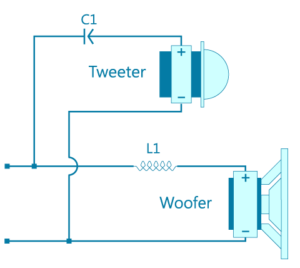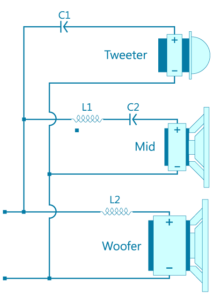2-way & 3-way System
Multi-way systems describe the use of multiple speakers to achieve the widest bandwidth possible. The intuitive way is to play all speakers at the same time, yet it can cause speakers to interfere with each other in terms of phase. This can result in small peaks and dips in the overall frequency response, and a muddy sound field. In reality, we use crossover to coordinate between different drivers, each suited and responsible for a specific frequency band. Take a two-way system as example, there’re usually a woofer and a tweeter; a three-way system would use a woofer, mid-range and tweeter. After the signal comes through the crossover made of various filters, the lower frequency proportion goes to the woofer, mid frequency to the mid-range, and high frequency to the tweeter. Usually some simple Low-Pass Filter (LPF) and High-Pass Filter (HPF) are deployed.
The principle is that below a certain crossover frequency point, a driver is designated to play out sound; after that crossover frequency point, another driver takes over to play the sound. Some mid-to-higher end notebooks marks the crossover point at roughly 3khz, and a woofer and tweeter coordinates between that point. At the crossover point, ensure that the two drivers’ phases should align with each other to avoid peaks or dips in the frequency response.
Sometimes a multi-way system emphasizes the spatial immersion that a set of drivers can create, such as the Dolby 5.1 system. On top of that, there’s so-called co-axial drivers, where the tweeter diaphragm is superimposed onto the woofer diaphragm. The advantage is that the sound field is natural, as all sounds come from a single point. Some high-end monitors utilize this kind of co-axial concept.
- Two-way crossover example

- Three-way crossover examples

